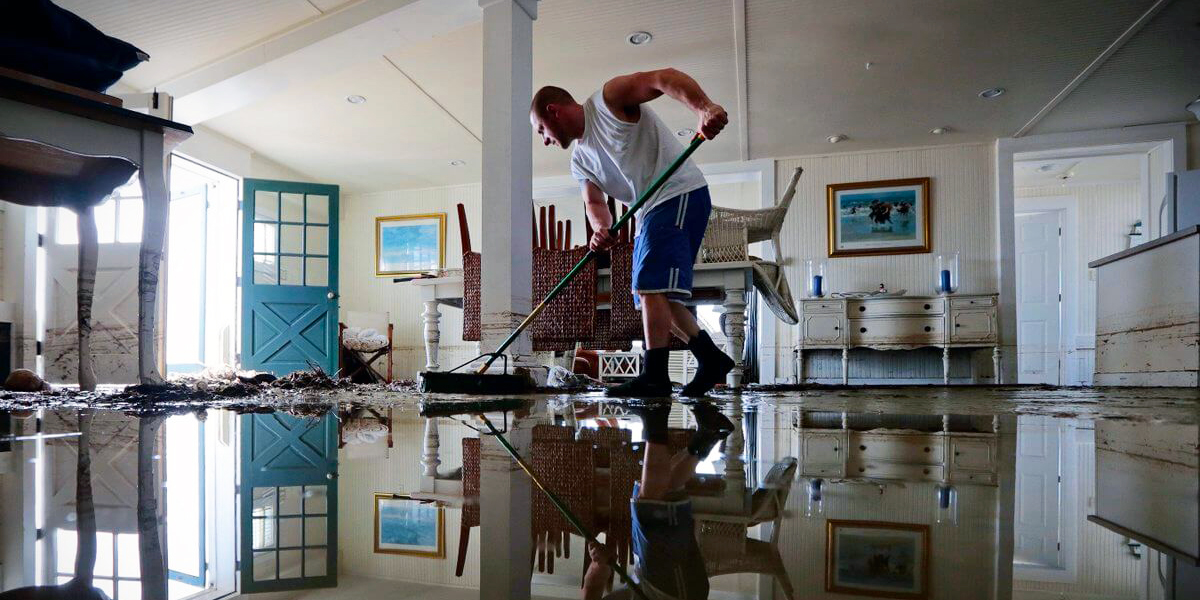Flood Damage Restoration
Major floods can be devastating occurrence… especially to your property. Damage to your home can run in the tens if not hundreds of thousands of dollars. This can ruin a home owner that doesn’t have flood insurance. If you’re one of the over million home owners without flood insurance, do-it-yourself (DIY) flood damage restoration might be your only remedy.
It’s extremely important to act quickly after your home has been affected by a flood. Mold growth sets in within a couple of days and needs to be prevented at any cost. Since I have extensive experience with concrete restoration, this article will focus on flood damaged homes that are on a concrete foundation. Most importantly, these tips and techniques will help you mitigate the damage caused by a major flood.
#1 – Get All Of The Water Out.
Pump out any stagnant water using a sump pump and a hose. A sump pump is a pump that is bottom feeding. You can get one of these at a hardware store or a garden store. Most sump pumps have the same threading as a garden hose. Hook up a hose to the pump, run it outside, then start pumping. This will remove the majority of the water.
Next you want to vacuum up any left over water using a wet / dry vacuum equipped with a squeegee wand. If you don’t already have one, a wet dry vac can be purchased at any hardware store for under $100. Above all, my personal favorite are the Rigid brand. Vacuum up any and all water from the floors of the home. Take your time when vacuuming up the water trapped in carpet. Carpet holds massive amounts of water so this might take a while. Dump the dirty water outside.
Place box fans around the home. If you have a dehumidifier, use that as well. All of the air movement will help dry out the areas quicker. If possible, run the heater in the home too. Most heating systems dry out the air which helps expedite the drying process. Certainly these techniques can be done throughout the entire restoration process.
#2 – Dispose Of Anything Beyond Repair
This step is one of the most mentally challenging. There’s going to be a lot of sentimental items that will have to go into the trash, and that always is painful.
This step should go hand and hand with the first step. The floors in each flood damaged room need to be completely cleared out to ensure a quick drying process. Move any salvageable furniture into a garage, pod, or upstairs room. Practically everything else needs to be thrown out to mitigate mold growth.
Then move any appliances to the garage or back yard during the restoration.
#3 – Remove Damaged Drywall
Next step is to rip out any flood damaged baseboards, drywall, insulation, carpet, laminate flooring, etc. as soon as possible. Firstly, I’ll start with the walls. Remove any baseboards first. I like to use a chisel and hammer for this but a crow bar works great as well. Then the drywall needs to be removed. Not all the drywall but just a couple inches above the water line. Start by poking a hole in the drywall and cutting a horizontal line above the water damage. You can use a drywall saw or sawzall for this. To clarify, always use a multimeter or or a similar device to test for electrical wires before sawing.
After the drywall is removed, the insulation has to be removed as well. Insulation can trap water and will increase mold growth in the walls. Cut out any insulation but be careful not to hit any wiring!
Door frames and other installations that can’t be removed should be wiped down or sprayed with bleach water to prevent mold growth.
#4 – Remove Damaged Flooring
Unfortunately the flooring has to go as well. Rip up any carpet and padding quickly since they hold a lot of water and mold will grow quickly in it. Laminate flooring has to be removed as well. Water can get trapped below the flooring and grow black mold. You can pop the laminate up with a floor scrapper.
#5 – Dry Out The Concrete
Concrete is like a sponge and will hold moisture for week at end. You can dry out the concrete in 24 hours by using a deep penetrating sealer. However, the tricky part is making sure that the concrete is free of adhesives. For example, if there are adhesives on the floor you might have to rent a floor machine from Home Depot and do a one over with diamond pads. This will remove any adhesives from the floor and leave the concrete raw and ready to be sealed.
Next, apply the deep penetrating sealer to the concrete. My personal favorite brand is Creto Deep Penetrating Sealer (DPS). This is applied by rolling it onto the concrete with a regular paint roller and extension. Keep the concrete wet for 30 minutes and then move on to the next area. This will push out any residual moisture and permanently waterproof the slab. This is essential so that the concrete doesn’t start to grow mold.
If the concrete starts to grow mold it will permanently smell musty in the house. It can also spread to the new carpet or other flooring that’s installed over it. This will make your home gross to be in and always remind you of the flood.
Do Your Due Diligence
This step is so easy and cheap it’s worth the time. Trust me! I’ve been multiple houses after the new flooring has been installed. It then has to be ripped out, the concrete treated / sealed, then reinstalled with new flooring.
All of these tips are time consuming but to prevent mold growth they have to be done. Flood damage restoration is an involved process and might take a couple weeks to complete. However, if it’s done it will prevent tens of thousands of dollars in mold growth mitigation and remediation in the future.
Moreover, these steps outlined above are suggestions and you should do your own due diligence for your own situation. In addition, here’s some additional info for flooding in the US.
Start On The Restoration
Now it’s time to start on the restoration! I recommend checking out “University of YouTube” for tutorial videos on how to patch drywall, mount baseboards, install laminate flooring, insulation, and many other DIY projects you have ahead. You can watch my videos on how to stain and seal your concrete instead of installing carpet or other flooring. In conclusion, good luck on your flood damage restoration project!
Tutorial Videos
Featured Product








